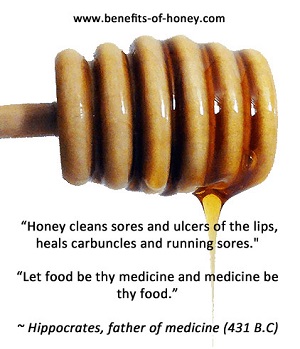
The Tastiest 100% Natural Antibiotic - Honey
Did you know that antibiotic can be natural, without side-effects, and tasty at the same time?
Honey as Folk Medicine
Before the advent of antibiotic, it was not unusual for an experienced medical professional to even slather honey on a wound to prevent infection and hasten healing. Honey has been used as a folk medicine for many different purposes: as a laxative, as a natural cure for diarrhoea and upset stomach, for coughs and sore throats. Then in the mid 1940's, antibiotics became available for the treatment of infections and honey was displaced from use in medicine.
Honey is Still Relevant Today
Today, this millennia old household natural remedy is being reinstated. Clinical observations have documented honey's effectiveness in treating cuts, burns, insect bites, yeast infections, various skin conditions such as eczema and psoriasis, and fungal infections from athlete's foot to ringworm. Many published reports described the healing properties of honey in rapidly clearing infection from wounds, with no adverse effects to slow the healing process and suggested that honey has an antimicrobial action against a certain spectrum of bacteria and fungi and may actively promote healing.

How does Honey Work as an Antibiotic?
Honey is effective as an antibiotic for wounds in several ways. When applied, honey releases slowly hydrogen peroxide (H2O2), an antibacterial, antimicrobial, and antiseptic compound produced from an enzyme, disinfecting the wound, killing the germs and healing the broken skin. Scientific evidence showed that most strains of harmful bacteria cannot survive in the presence of oxygen or hydrogen peroxide. (If you have read my pages on honey storage and, good honey quality you probably know that honey doesn't need to be refrigerated as bacteria don't survive well in it, that is, it doesn't spoil!)
Today the increasing number of antibiotic-resistant microbial species has flagged the critical need for other more effective antibacterial substances. Many studies on honey have drawn comparisons with the activities of conventional antibiotics and proven the antibacterial activity of honey and its effective use in the treatment of infection and diseases (International Journal of Microbiology, Vol. 2019).
Honey's viscosity provides a protective barrier and forms a moist environment for the wound. It creates a healing layer between wound and dressing with no sticking and no tissue damage, reducing the chance of scarring as the skin cells grow without forming any scab. Honey supplies nutrients necessary for healthy tissue regeneration and stimulates the growth of new blood capillaries. The antibacterial properties also provide a barrier to cross-infection of wounds. Honey's high sugar content has an osmosis effect on wounds. It draws lymph out to the cells while absorbing moisture and provides an anti-inflammatory action which reduces swelling and pain.
Honey contains a large amount of glucose, a simple sugar that combines chemically with collagen, a tissue protein. Hence, when applied to burns or wounds, honey often heals without leaving scars. The acidity of honey also promotes healing. It's also believed that honey even makes wounds smell better, possibly because when bacteria in wounds eat honey's sugars, they give off sweeter-smelling gases.
Manuka The Medihoney
Honey is produced from many different floral sources and its antibacterial potency varies with origin and processing. Manuka honey, for instance is known to have relatively more antibacterial activity and strong curative properties. It is already available as a wound dressing and currently being sold under the name "Medihoney" through online pharmacies in the US and in regular pharmacies in Australia.
End of "The Tastiest 100% Natural Antibiotic - Honey". Back to "Health Benefits of Honey"